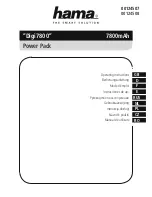
5
Original Instructions
sides of the wheel.
■
Use extra caution when making a “pocket cut” into
existing walls or other blind areas.
The protruding
wheel may cut gas or water pipes, electrical wiring or
objects that can cause kickback.
Safety warnings specific for wire brushing operations
■
Be aware that wire bristles are thrown by the brush
even during ordinary operation. Do not overstress
the wires by applying excessive load to the brush.
The wire bristles can easily penetrate light clothing and/
or skin.
■
Allow brushes to run at operating speed for at least
one minute before using them. During this time no
one is to stand in front or in line with the brush.
Loose bristles or wires will be discharged during the run-
in time.
■
Direct the discharge of the spinning wire brush
away from you.
Small particles and tiny wire fragments
may be discharged at high velocity during the use of
these brushes and may become imbedded in your skin.
ADDITIONAL SAFETY WARNINGS
■
Inspect for and remove all nails from the workpiece
before using the product.
Following this rule will
reduce the risk of serious personal injury.
■
Do not reach in the area of the spinning bit.
The
proximity of the spinning bit to your hand may not always
be obvious.
■
The product is not intended for use as a dental drill
or in human or veterinary medical applications.
Serious injury may result.
■
Do not grind or sand heat flammable materials.
Sparks from the wheel could ignite these materials.
■
Do not bend the flex shaft with a radius less than
13 mm. The risk of overheating will increase
substantially.
■
Clamp workpiece with a clamping device.
Unclamped
workpieces can cause severe injury and damage.
■
Injuries may be caused, or aggravated, by prolonged
use of a tool. When using any tool for prolonged periods,
ensure you take regular breaks.
■
Ambient temperature range for tool during operation is
between 0°C and 40°C.
■
Ambient temperature range for tool storage is between
0°C and 40°C.
■
The recommended ambient temperature range for the
charging system during charging is between 10°C and
38°C.
ADDITIONAL BATTERY SAFETY WARNINGS
■
To reduce the risk of fire, personal injury, and product
damage due to a short circuit, never immerse your
tool, battery pack or charger in fluid or allow a fluid to
flow inside them. Corrosive or conductive fluids, such
as seawater, certain industrial chemicals, and bleach
or bleach-containing products, etc., can cause a short
circuit.
■
Ambient temperature range for battery during use is
between 0°C and 40°C.
■
Ambient temperature range for battery storage is
between 0°C and 20°C.
TRANSPORTING LITHIUM BATTERIES
Transport the battery in accordance with local and national
provisions and regulations.
Follow all special requirements on packaging and labelling
when transporting batteries by a third party. Ensure that
no batteries can come in contact with other batteries
or conductive materials while in transport by protecting
exposed connectors with insulating, non-conductive caps or
tape. Do not transport batteries that are cracked or leaking.
Check with the forwarding company for further advice.
KNOW YOUR PRODUCT
See page 8.
1. Spindle lock lever
2. Collet nut
3. On/off switch
4. Accessory storage
5. Wrench holder
6. Speed control dial
7. Pen holder
8. Cord
9. Rotary tool
10. Battery port
11. Operator’s manual
12. Battery pack
13. Charger
MAINTENANCE
■
The product should never be connected to a power
supply when assembling parts, making adjustments,
cleaning, performing maintenance, or when the product
is not in use. Disconnecting the product from the power
supply will prevent accidental starting that could cause
serious injury.
■
When servicing, use only original manufacturer’s
replacement parts, accessories and attachments. Use
of any other parts may create a hazard or cause product
damage.
■
Avoid using solvents when cleaning plastic parts. Most
plastics are susceptible to various types of commercial
solvents and may be damaged by their use. Use clean
cloths to remove dirt, carbon dust, etc.
■
Do not at any time let brake fluids, gasoline, petroleum-
based products, penetrating oils, etc., come in contact
with plastic parts. Chemicals can damage, weaken or
destroy plastic which may result in serious personal
injury.
■
For greater safety and reliability, all repairs should be
performed by an authorised service centre.
SYMBOLS ON THE PRODUCT
Safety alert
No-load speed
Rated speed
V
Volts
Direct current






























